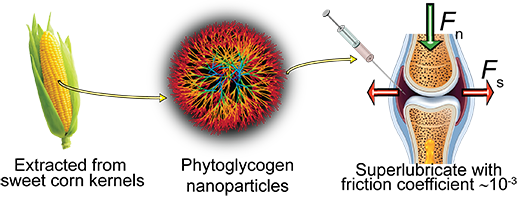| May 25, 2021 | |
High-performance biolubricants made from corn starch |
|
| (Nanowerk Spotlight) When you hear about lubrication in the context of your body, you most likely will immediately think about your knees or elbows because diseases such as osteoarthritis impair the body's natural biolubrication. However, biolubrication is not limited to these synovial joints. Lubricating films of biomacromolecules are present in most interfaces in the human body where they provide ultra-low friction and maintain normal physiological function by preventing wear at the surface of the interfaces. Our body needs lubrication in eyes, mouth, skin, hair, gastrointestinal and reproductive tracts. Losing lubrication in each of these body parts results in pain or discomfort. | |
| Nature has developed excellent biolubricating systems and a healthy knee, for instance, functions at a friction coefficient (the ratio between friction and applied load) as low as ∼10-3 to 10-2 (if you want to learn more about friction in general, have a look at our primer). | |
| Once biolubrication of synovial joints of osteoarthritis patients breaks down, relief has to come from partially or fully synthetic biolubricants – such as polymeric micro- or nanoparticle-based lubricants – that replace the depleted natural substances. | |
| "Synthetic hydrated macromolecules such as polyelectrolytes, zwitterionic polymers and polysaccharides are effective boundary lubricants, however, bio-sourced polymers can improve the performance of synthetic polymers and are highly desirable for sustainable design of biolubricating materials" Eugenia Kumacheva, a professor at the University of Toronto, tells Nanowerk. | |
| In a recent study in ACS Nano ("Phytoglycogen Nanoparticles: Nature-Derived Superlubricants"), Kumacheva and her group at University of Toronto, in collaboration with Banquy at Universit´ de Montréal, demonstrate that phytoglycogen nanoparticles (PhG NPs) – single-molecule highly branched polysaccharides extracted from sweet corn kernels – are a highly effective biolubricating material. | |
 |
|
| Schematic representation of this work. (Image: Dr. Eugenia Kumacheva, University of Toronto) | |
| "We were able to demonstrate that PhG NPs are as effective biolubricants as the best-performing synthetic macromolecules," says Vahid Adibnia, a postdoc in Kumacheva's group and the paper's first author. "These nanoparticles have been extensively studied for drug delivery applications, as well. A combination of their hydration capacity and drug loading capability motivated us to study their biolubrication properties as the initial step toward introducing these nanoparticles as effective treatments for osteoarthritis." | |
| In addition to discovering a biosourced and biocompatible lubricating material, the University of Toronto team's study digs deep into the nanomechanics of lubrication by PhG NPs and describes the role of water molecules in biolubrication. | |
| Water molecules in films of hydrophilic polymers exist in two states: they are either bound to the polymer molecules by hydrogen bonding or are in the free state. In their study, the researchers distinguish the contribution of water molecules that are bound to the polymer chains from the water molecules that diffuse freely. | |
| They show that the superlubricating properties of PhG NPs depend on the synergistic contribution of these two populations of water. The insights that are obtained from this result can alter the way that synthetic biolubricating polymers are designed. | |
| Because of their biocompatibility, PhG NPs not only are promising candidates for lubrication in biological environments but the chemical and physical modification of these nanoparticles could also provide the capability of combining their excellent lubricating performance with drug delivery applications. | |
| The most significant and immediate potential application of this nanoparticle system would be for osteoarthritis treatment, with the objectives of improving lubrication and wear protection in the joints as well as delivering drugs into the joint in a time-controlled manner. | |
| Apart from the primary objective of establishing their application as a drug delivery platform for osteoarthritis treatment, Kumacheva's group will investigate the interactions of these nanoparticles with macromolecules found in the synovial fluid, the lubricating liquid in mammalian joints. | |
| In addition, they plan to test the lubricating performance of the PhG NPs on cartilage surfaces in vitro. In a further step, they will evaluate in vivo efficacy of drug-loaded PhG NPs on osteoarthritis joints of adult mice by quantifying changes to joint inflammation and fibrosis. | |
| The intended result will be a comprehensive drug-delivery platform for arthritis treatment, which provides patients with short-term relief of symptoms through lubrication, and long-term disease-modifying effects through the delivery of active therapeutic agents. Phytoglycogen nanoparticles can potentially satisfy both these requirements, in addition to being biocompatible and abundantly accessible from natural sources. | |
| "Lubricating media in the human body are complex and are often composed of multiple components that synergistically contribute to the lubrication – any artificial system that is administered to the body to help with lubrication must be compatible with different components of this natural system," Kumacheva concludes. "Therefore, developing new materials for this type of applications is challenging. We have taken the first step towards the application of PhG NPs as natural lubricants and, going forward, we plan to conduct multifaceted research to combine their lubrication properties with drug delivery applications." | |
 By
Michael
Berger
– Michael is author of three books by the Royal Society of Chemistry:
Nano-Society: Pushing the Boundaries of Technology,
Nanotechnology: The Future is Tiny, and
Nanoengineering: The Skills and Tools Making Technology Invisible
Copyright ©
Nanowerk LLC
By
Michael
Berger
– Michael is author of three books by the Royal Society of Chemistry:
Nano-Society: Pushing the Boundaries of Technology,
Nanotechnology: The Future is Tiny, and
Nanoengineering: The Skills and Tools Making Technology Invisible
Copyright ©
Nanowerk LLC
|
|
|
Become a Spotlight guest author! Join our large and growing group of guest contributors. Have you just published a scientific paper or have other exciting developments to share with the nanotechnology community? Here is how to publish on nanowerk.com. |
|
